Carolina Reapers are the hottest peppers in the world, so it’s no surprise that many people are interested in growing them. The growing process can be difficult, as they are not particularly hardy plants. However, they are satisfying to grow and will certainly be used by those interested in cultivating the hottest pepper in the world.
Here is a complete guide covering common questions and concerns about growing Carolina Reapers.

Step-by-step Guide for Growing Carolina Reaper Peppers in a Garden
Growing Carolina Reaper plants in a garden is a simple process that should not require much work after the initial preparation. However, it does present unique challenges when compared to growing them indoors.
- Ensure the timing is correct: temperatures will need to be above 70 degrees Fahrenheit during the day to get healthy growth of Carolina Reapers. Consider their long growth time when planting and make sure the season is correct.
- Prepare the seeds: soaking the seeds in black tea for about 30 minutes can help soften their shells and make them easier to grow
- Prepare the soil: Test your garden’s soil pH level and ensure it is around 6.5. Otherwise, the Carolina Reaper may not grow. Add potting soil or dirt blends to balance the soil and ensure it is healthy for plant growth.
- Sow the seeds: Plant the seeds about ⅛ inch deep in the soil or potting mix. Dampen the soil with water, but only enough to make sure it’s not dry.
- Wait for germination: continue watering the plant about two inches per week until germination occurs, which can take up to six weeks. Once the plant has sprouted, add a light fertilizer mix and continue light watering.
- Give it time: the plants are now growing! Bulbs of peppers will soon appear, which can take an additional 100 days or so to fully ripen. Continue the light work of gardening the plants and ensuring that temperatures are correct. Consider moving them inside a greenhouse or indoors if the season will change soon.
Step-by-step Guide for Growing Carolina Reaper Peppers in a Pot
Many people choose to grow Carolina Reapers in pots and indoors instead of in a garden because it is easier to control the temperature, which is a key requirement of healthy Carolina Reaper plants. Doing this will require some space and setup but may ultimately be healthier for the plants.
In fact, the original creator of the Carolina Reaper pepper grows his own peppers in pots.
- Set the right temperature: Either use heat mats underneath the pots or keep the pots outside while the weather is warm. Ensure that the plants will get enough sunlight and warmth. Temperatures should stay above 70 degrees Fahrenheit during the day.
- Prepare the seeds: Soaking the seeds in black tea for about 30 minutes can soften their shells and promote growth.
- Use a large pot: Carolina Reaper plants can grow up to four feet tall and six feet wide, so it is important to get a large container. Three gallons is an absolute minimum, and 5-gallon pots are preferred.
- Use potting soil: Use healthy and sterile potting soil with a pH balance of roughly 6.5 to ensure healthy growth. Make sure the potting soil drains well and will not accumulate too much water which drown the plant.
- Sow the seeds: Place the seeds about ⅛ an inch deep in the soil and water lightly.
- Wait for growth: the germination process can take up to six weeks, and the growth process of the plant almost 100 days. Continue to water the plant about two inches every week. After the plant has grown, peppers will take roughly another 100 days to ripen before they are ready to be picked.
I love writing about Carolina Reaper peppers, check out some of my other posts on growing the pepper!
Carolina Pepper Growing Quicklinks
- Best Container Sizes for Growing Carolina Reapers
- Carolina Reaper – Soil and Fertilizer Guide
- How to Quickly Germinate Carolina Reaper Seeds
What are Carolina Reapers?
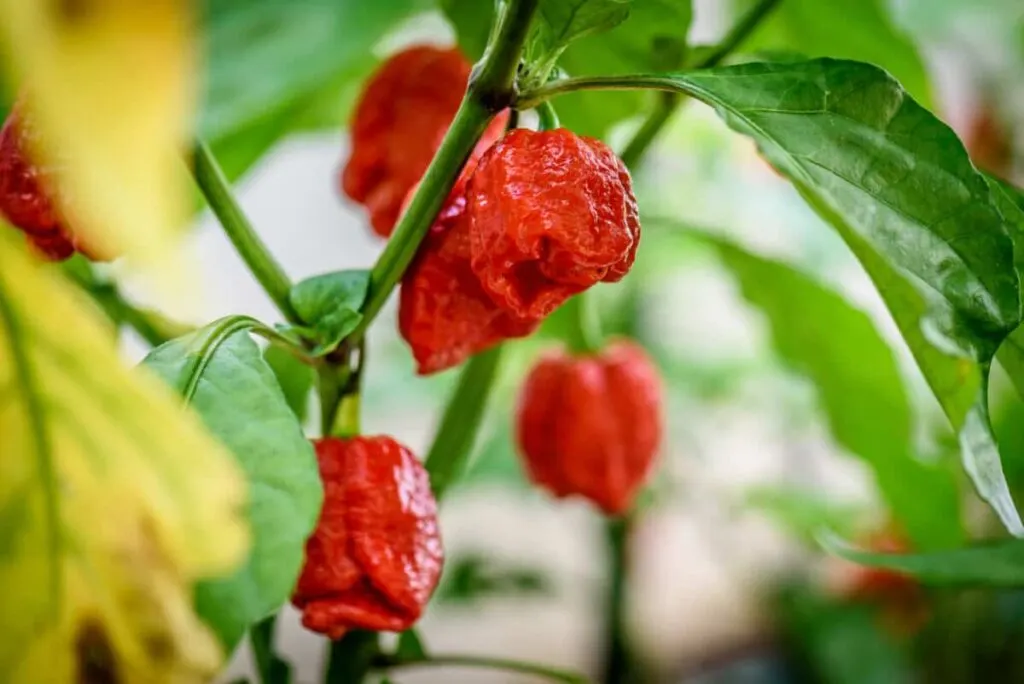
Carolina Reapers are the hottest pepper in the world, clocking in at over 2 million Scoville units. The Carolina Reaper is a cross-breed of two other extremely hot peppers: the Pakistani Naga Viper pepper and the St. Vincent La Soufriere pepper from the Caribbean.
Carolina Reapers have a distinct and sweet flavor before the heat kicks in, so it is important to be extra careful when eating them. The spicy heat will come down on you like no other pepper you have eaten before. Just give it a bit of time as the onset of the heat has a slight delay.
The pepper itself also looks unique, given its small and wide stature. They have a distinct, scorpion-like tail at the end of the pepper. Most are red, but you can find varieties in other colors like yellow or peach.
Are Carolina Reaper Peppers Hard to Grow?
Carolina Reapers are no harder to grow than any other pepper plant. However, they require an extremely long growing season, so in many climates, they will have to be started indoors and then moved outdoors.
This long growing season also introduces more opportunities for the process to go wrong, so it is important to be vigilant. Pepper plants are often considered fragile, and the longer they must survive before bearing fruit, the more complicated things can become.
With that said, most attentive and caring gardeners will be able to grow Carolina Reapers at home with just a bit of effort.
How Long Do Carolina Reaper Peppers Take to Grow?
Carolina Reaper plants take 90 to 100 days to grow. Given that peppers require hot temperatures and are sensitive to changes in the soil, this means that they often are planted at least six weeks before the normal planting season.
Germination, or when sprouts appear, can also take additional time for the Carolina Reaper. So do not panic if you still haven’t seen a seed sprout for two weeks; this is a common occurrence.
If you are worried that your Carolina Reapers are growing too slowly, check out my article 6 Reasons Why Your Carolina Reaper Plant is Growing Slowly for answers why.
What is the Best Climate to Grow Carolina Reaper Peppers?
The best climate for growing Carolina Reaper peppers is warm and humid. When they are planted outside, daytime temperatures must consistently stay above 70 degrees Fahrenheit, while nighttime temperatures should not go below 50 degrees Fahrenheit.
While Carolina Reapers, much like most super-hot peppers, struggle in the cold, they can also be damaged by temperatures that are too warm. Any climate consistently seeing temperatures over 85 to 90 degrees Fahrenheit may present issues for growing the pepper.
Soil balance also plays a role in the growth of Carolina Reapers. As a rule, Carolina Reapers do best in soils with a pH of around 6.5. Soils that are too basic or acidic will prevent plants from producing peppers.
What is the Best Time to Plant Carolina Reaper Seeds?
Due to the Carolina Reaper’s long growing time and fickle temperature requirements, it is best to start cultivating the plant in early spring.
Carolina Reaper plants take between 90-100 days to fruit with pepper pods. With that in mind, as well as their need for warm temperatures, you should align the planting so that the peppers are ready to go by the end of summer at the latest.
It is highly recommended to start the seedlings indoors, where you can control the temperature and ensure that they will not experience any frost. After about six weeks, or when there is no chance of frost freezing the plant, they can be moved outside.
What Type of Soil is Best to Grow Carolina Reaper Peppers?
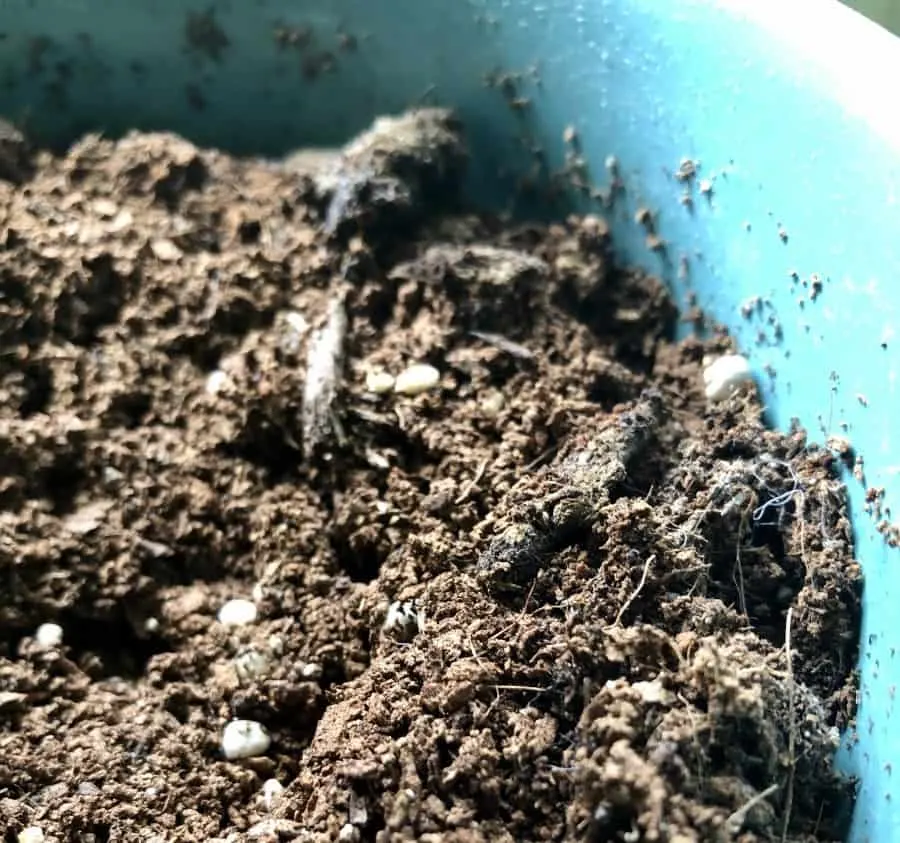
To grow Carolina Reapers, the optimal soil has a pH of around 6.5. This is right around the middle of the pH scale, with a slightly acidic tilt. The majority of peppers grow best at this acidic level.
The soil should be well-hydrated but not over-watered or you might drown the pepper plant. Ensure that the soil is well-draining to help prevent this issue. Providing the Carolina Reaper plant with about 2 inches of water each week should be the perfect amount.
The more organic matter found in the soil, the better. This will help the Carolina Reaper plant grow and stay healthy. The soil should also be free of fungus and parasites, as these can cause severe damage and possibly even kill the pepper plant.
What Type of Fertilizer is Best to Grow Carolina Reaper Peppers?
The best types of fertilizer for a Carolina Reaper plant are either fish emulsion or a 5-10-5 fertilizer.
Fertilizers with high levels of nitrogen should be avoided, as they are not helpful for fruit production. Only start fertilizing the Carolina Reaper plant after blossoms have appeared. Doing it earlier will not help the plant grow, as it is in the germination stage, and will only amount to a waste of money.
How Often Should You Water Carolina Reaper Plants?
Carolina Reaper pepper plants do not require much water at all. In fact, it is surprisingly easy to drown them with too much water if you are not careful.
Carolina Reaper plants should receive about two inches of water per week, spread throughout multiple days. Ensure that the soil is not drying out or retaining a lot of water. Spreading the two inches throughout the week will help keep a healthy environment for plant growth.
Are Carolina Reaper Plants Self-Pollinating?
In general, Carolina Reaper plants are self-pollinating and will require no additional work from you to reach full maturity. Occasionally, however, their self-pollination will stall and require additional help.
Most of the time, if your Carolina Reapers are having difficulties pollinating or reaching full ripeness, a simple, soft brush can be used to activate their pollination. Keep in mind that this is unnecessary the majority of the time.
Self-pollination is largely carried out by breezes and insects moving across the plants, which is unlikely to happen indoors, so it will be more common that you need to give the plants a little help when they are grown indoors.
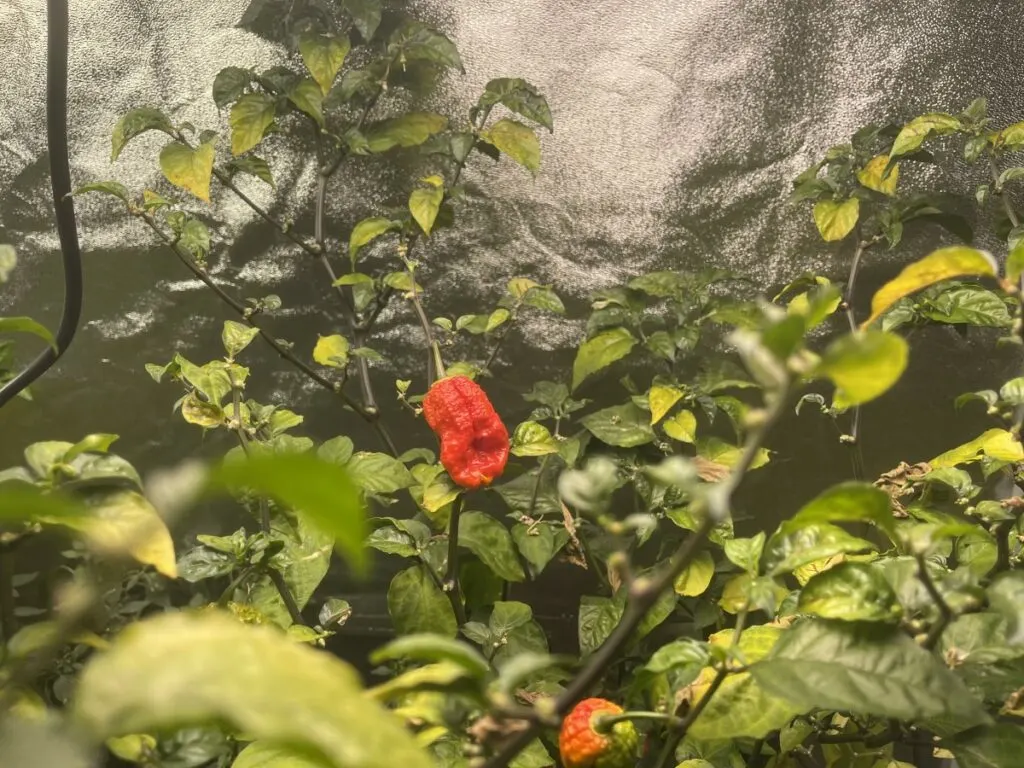
When to Pick Carolina Reaper Peppers and How Long Does It Take for the Pods to Turn Red?
Try to pick Carolina Reaper peppers as late in the ripening process as possible, assuming that a frost is not going to hit and possibly kill the peppers. They take an extremely long time to ripen fully, most commonly around 100 days.
The longer you wait to pick the Carolina Reaper, the hotter it will be. While they are safe to pick and eat in the early stages of growth while still green, you will lose out on quite a bit of their famous heat if you pick them this early.
Carolina Reaper peppers turn red when they are fully ripe, about 100 days after growth. They can ripen off the plant, but this will reduce the peppers’ spiciness.
Will Carolina Reaper Peppers Ripen Off the Plant and How Long Does the Ripening Process Take?
Carolina Reapers take an extremely long time to ripen, often up to another 100 days. This long ripening time is largely due to how hot they are. In general, the hotter the pepper, the longer the ripening period.
Carolina Reapers, like most peppers, can ripen off the plant, but it will result in a milder pepper as the capsaicin hasn’t had enough time to reach full concentration. It’s almost always better to wait and pick the peppers off the plant after they have ripened fully. Otherwise, you will lose out on some of the signature heat.
The ripening of Carolina Reapers should be a hands-off process. Once the pepper has fruited, it is likely that it will survive and be healthy, so give it the time it needs to fully ripen on the plant. If a frost is coming, consider moving the plant indoors in a large, 5-gallon container to let the ripening process continue.
How Big Do Carolina Reaper Pepper Plants Get?
Carolina Reaper plants can get quite large, and as such require large pots if you are growing them indoors. A fully grown Carolina Reaper plant can reach up to four feet tall and six feet wide.
Growing the plants far enough away from each other that they are not touching is a great way to help keep them healthy and reach full size, which will ensure a large batch of peppers at the end of the season.
Can Carolina Reaper Peppers be Grown in Containers?
Carolina Reapers can be grown in containers, although they need a large amount of space. A 3-gallon container is generally the minimum size recommended, but if it is possible for you to use a larger container size, a 5-gallon container is going to make the plant’s growth much easier.
In fact, because of the Carolina Reaper plant’s long growing process, it is highly recommended that you start growing them in containers indoors for the first few weeks. It is possible to move the plants from the container to the ground and vice-versa, although doing so will stress the plant and possibly cause growth issues.
Containers should be well-draining and have balanced soil with room for the Carolina Reaper plant to grow. Otherwise, you may not get peppers or even have the plant pass the germination stage due to stress.
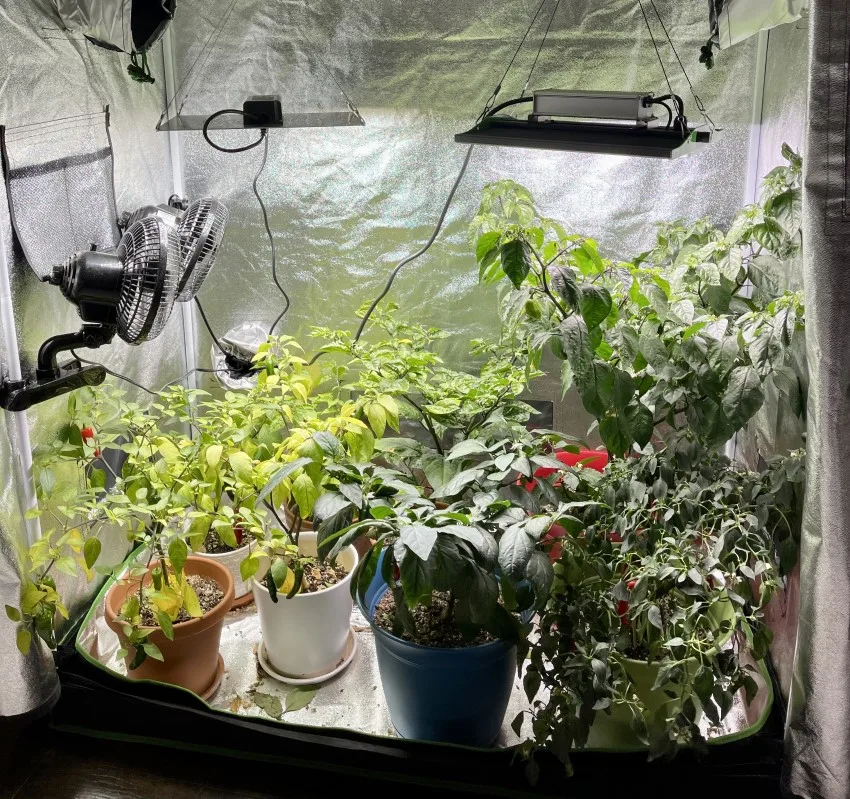
Can Carolina Reaper Peppers be Grown Indoors?
Carolina Reaper peppers can be grown indoors, and many often start their growing process indoors. Peppers are highly susceptible to cold temperatures and frost, so there are extremely few climates in the world where they can grow totally outdoors undisturbed.
Most Carolina Reaper plants spend the first few weeks of their growing process indoors before being moved outside for the remainder of the process, but this is not necessary. Assuming you provide a large enough container and temperature control, there is no reason why Carolina Reapers could not be grown indoors.
There is a chance when growing Carolina Reapers indoors that you may need to assist in pollination to ensure that the peppers ripen properly. To do so, gently move your finger or a soft paint brush along the stems of the peppers. This will release the pollen and allow it to settle on other pepper plants.
How Many Carolina Reaper Peppers Do You Get Per Plant?
A typical Carolina Reaper plant will produce between 20 to 30 peppers when fully grown, although this number can be significantly higher, with some reports of over 50 peppers coming out of one plant.
The amount of peppers is a bit less than other pepper plants, but that largely doesn’t matter thanks to the Carolina Reaper’s incredible heat. One of these peppers can go much farther than even 10 others in terms of heat.
Are Carolina Reaper Pepper Plants Annual or Perennial?
Carolina Reaper pepper plants are perennial, much like most pepper plants. However, given their strict growth requirements, they must largely be grown indoors in order to see results year-round.
So long as their conditions of temperature, water, and sunlight are being met, Carolina Reapers will continue to produce peppers at all times. This is why indoor or greenhouse growth is extremely popular for these peppers.
Common Pests to Watch Out for When Growing Carolina Reaper Peppers
Pests and insects attacking or eating pepper plants is a common occurrence, and Carolina Reaper plants are no exception. Some of the most common pests that appear on pepper plants are:
- Cutworms
- Slugs
- Grasshoppers
- Flea beetles
- Aphids
Many of these are harmless, but when they appear in large numbers, any pest can cause growth or health issues for your Carolina Reaper plants. Aphids, in particular, commonly carry diseases which can harm or even kill your pepper plants. To prevent pests, plant the seeds far enough apart from other plants that they are not touching, and keep your garden weed free.
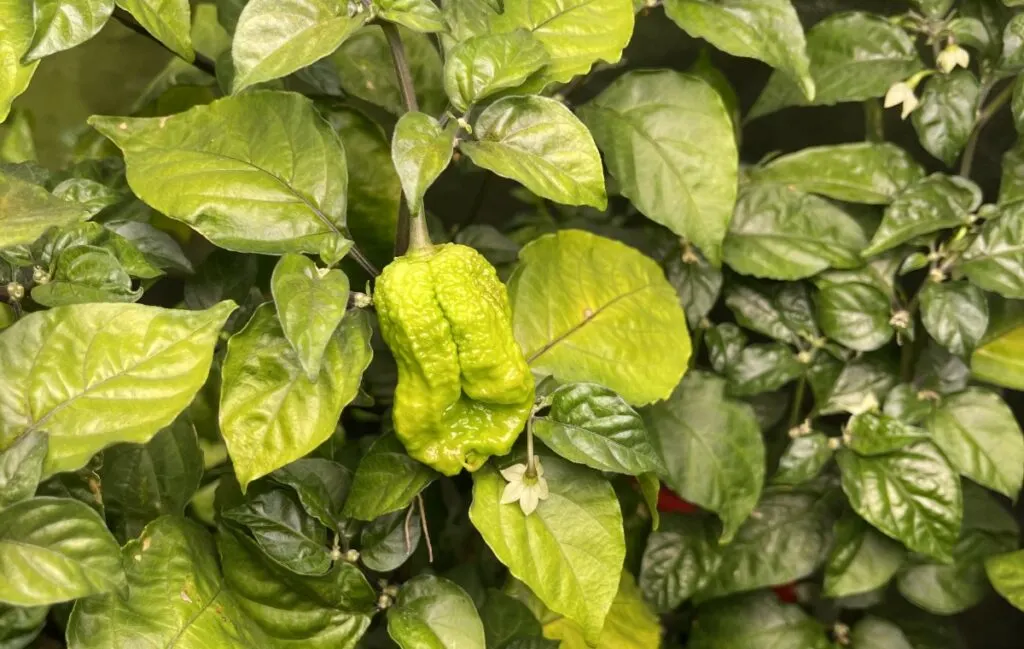
Common Mistakes Gardeners Make When Growing Carolina Reaper Peppers
There are a few common gardening mistakes that first time Carolina Reaper pepper growers usually make:
- Overwatering: Pepper plants really do not need much water at all, and this is an easy way to accidentally kill the plant. Two inches of water per week is a general rule, but simply watering the soil just enough so that it doesn’t dry out is enough.
- Not wearing protective equipment: Picking your Carolina Reapers off the plant is an exciting time, but it’s important to remember just how hot these peppers are. Just the oil from the pepper’s skin can cause burning sensations, so be sure to wear protective gloves and wash your hands and equipment thoroughly before moving on to any other tasks.
- Rushing the harvest process: Carolina Reapers take a tremendously long time to grow, and even more time to ripen. Be patient and give it the time it needs to grow and thrive, and you won’t be disappointed! Check your temperature, water, and sunlight to make sure everything looks good, and one day you will be pleasantly surprised to see the peppers ripened.
I have an entire post about how to revive a dying Carolina Reaper plant you should check out if you’ve made some potentially fatal errors while growing your Carolina Reaper!
What is the Best Way to Store Carolina Reaper Peppers?
Carolina Reapers can be stored a variety of ways depending on how you plan to use them and how long they will be kept in storage.
For relatively short-term storage, about two or three weeks, they can simply be stored fresh in a cool, dry place like the fridge. Freezing the peppers can make them last much longer and will ultimately not affect their heat or flavor too much, making it a great choice for long-term storage.
If you have a specific use in mind for the Carolina Reaper pepper, you may be able to roast or dry the pepper, if the use fits. Both of these methods make the peppers last much longer, but they have to be used in a specific form later on.
